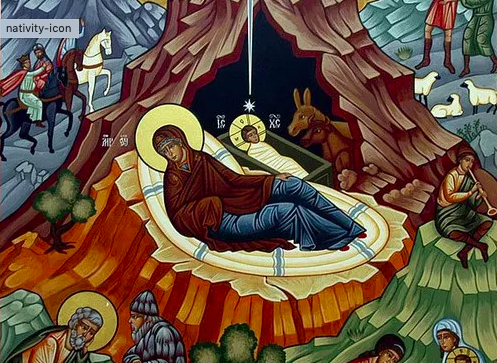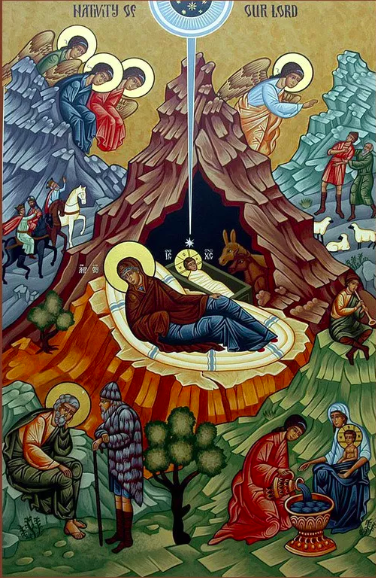Christmas Services: What Did You Hear?

I hope everybody is having a rich and restful Christmas Day. I thought it might be fun for Christian readers to talk about what we heard, saw, or observed at Nativity services, if your church had them. This morning at the Divine Liturgy, I was struck by a troparion (short hymn) sung by our choir. Here are the words (emphasis mine):
Thy Nativity, O Christ our God,
has shone to the world the light of wisdom!
For by it, those who worshipped the stars,
were taught by a star to adore Thee,
the Sun of righteousness,
and to know Thee, the Orient from on high.
O Lord, glory to thee!
What a marvelous sentiment. The hymn-writer is talking, of course, about the Magi, who were probably astrologers. The theological point here is that everything in the cosmos points to Jesus Christ, the Logos, through whom it was created.
The contemporary Orthodox Christian theologian Dumitru Staniloae writes in his great book Orthodox Spirituality about contemplating God in Creation. In this passage, he is teaching about the cosmic vision of St. Maximus the Confessor, the 7th century theologian:
So it is a main idea of St. Maximus that things hide divine logoi in them, as so many rays of the supreme Logos. He who discovers them in things ascends on their thread to the knowledge of God and this knowledge must anticipate His direct knowledge.
This teaching attributes to creation and the thought referring to it a necessary role in the ascent of man to God. St. Maximus is a stranger to the idea of a vision which we might attain by bypassing the forms and laws of the cosmos. On the road of our approach to God stand the world — we must pass through the understanding of it. Every man has a mission connected with the world. Everyone must know it according to the power given to him, inasmuch as knowledge can’t come until the gaining of the virtues; everyone must develop beforehand a moral activity in relationship to the world. A mainly negative attitude toward the world frustrates salvation itself. The world is imposed on everyone as a stone for sharpening his spiritual faculties.
By the world man grows to the height of the knowledge of God and to the capacity of being HIs partner. The world is a teacher to lead us to Christ. Of course it can also be the road to hell. It is the tree of the knowledge of good and evil, the tree of testing. It we look at its beauty in order to praise its Creator, we are saved; if we think that its fruit is pure and simply something to eat, we are lost. Salvation isn’t obtained in isolation, but in a cosmic frame. This value of the world as a road to God is explained by the fact that man must have an object of giant proportions for strengthening his spiritual forces, but also from the intrinsic structure of the world as a symbol of transcendent divine realities. A symbol (from the Greek symballein, to throw together, to united two things without confusing them), is a visible reality which doesn’t only represent, but somehow makes an unseen reality visible. A symbol presupposes and shows two things simultaneously. It is “a bridge between two worlds” as somebody has said. A work, for example, is a symbol of the spirit, uniting and simultaneously presenting the materiality of the sound with the meaning of thought without confusing them the human face likewise, makes the spirit in man transparent by its materiality, and if he is living in Him, God Himself. A symbolic consciousness of the world:
… sees everywhere in this world the signs and symbols of another world, and perceives the divine as the mysterious and infinite, beyond that which is finite and transitory. (Berdyaev)
All flesh is a symbol of the spirit, the reflection the image, and the sign of another far off, yet much more profound, reality.
The life of faith is so adventurous. The Magi set out, following a star, and it turned out to be a sign that led them to communion with the One who made the stars. If you see rightly, with a contemplative mind, the world is endlessly rich in meaning.
I didn’t “hear” all of this theology, literally, at the Divine Liturgy this morning. That troparion, though, brought it all back. Orthodox Christian worship is rather catechetical — not dry and didactic, I hasten to add, but let’s just say not a word is wasted.
So, at your church’s Christmas services, what did you hear? See? Think about?
By the way, below is the full image of the Orthodox icon of the Nativity. The website Orthodox Road, from where I took it, has a good explanation of what’s going on, and what it all symbolizes:

